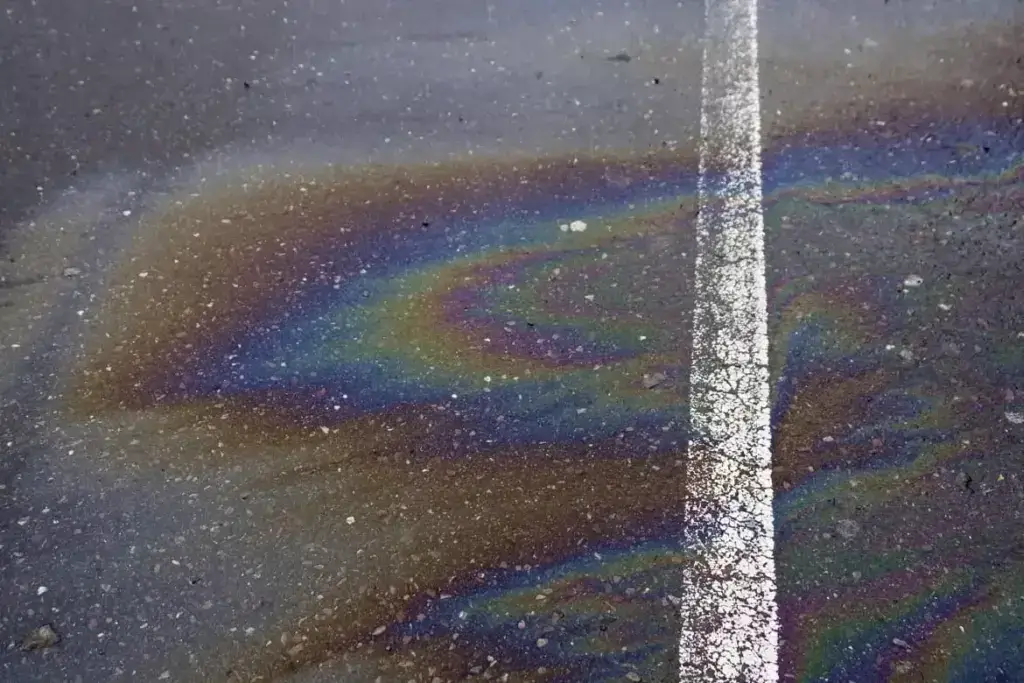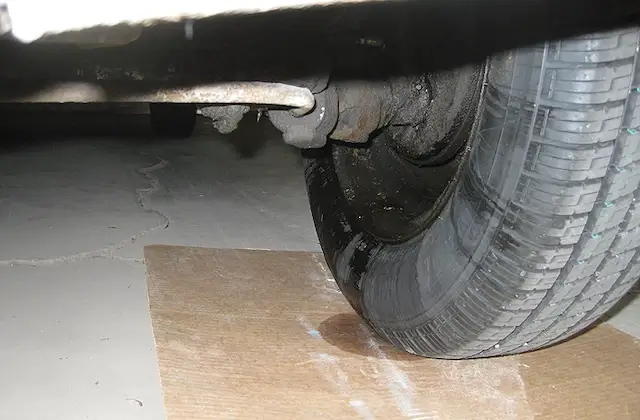Puddle of liquid under car — what is leaking
How to determine what that puddle of liquid is under your car to find out what’s leaking
Where is the puddle of liquid under your car?
If the puddle of liquid under your car is toward the front of the car, scroll down to forward leaks
If the puddle of liquid is under the middle, scroll to middle leaks
If the puddle is toward the read, scroll to leaks toward rear of car
If the puddle is near a tire, scroll to tire leaks
Forward leaks — Diagnosing leaks under the front of your vehicle
Radiator and coolant leaks are common up front
The radiator is located directly behind the grille of 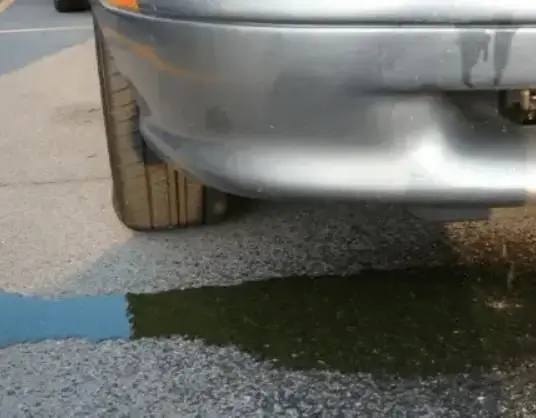 your car. It holds about a gallon of engine coolant. If the radiator or radiator hoses are leaking, the leak will form a liquid puddle under the front of your vehicle. Coolant colors vary and can be green, blue, red, pink, yellow, orange and even purple.
your car. It holds about a gallon of engine coolant. If the radiator or radiator hoses are leaking, the leak will form a liquid puddle under the front of your vehicle. Coolant colors vary and can be green, blue, red, pink, yellow, orange and even purple.
To determine if it’s coolant, touch the liquid and roll it between your fingers (or don a latex or nitrile glove first). Coolant is fairly thin, almost watery, but slightly slippery. It has a slightly sweet smell.
Pop the hood and use a flashlight to examine the radiator hoses, radiator and coolant reservoir for signs of leaks.
A coolant leak is serious and should be addressed as an emergency. Loss of coolant can result in engine overheating which can destroy your engine, costing upwards of $5,000 to $10,000.
Windshield washer fluid
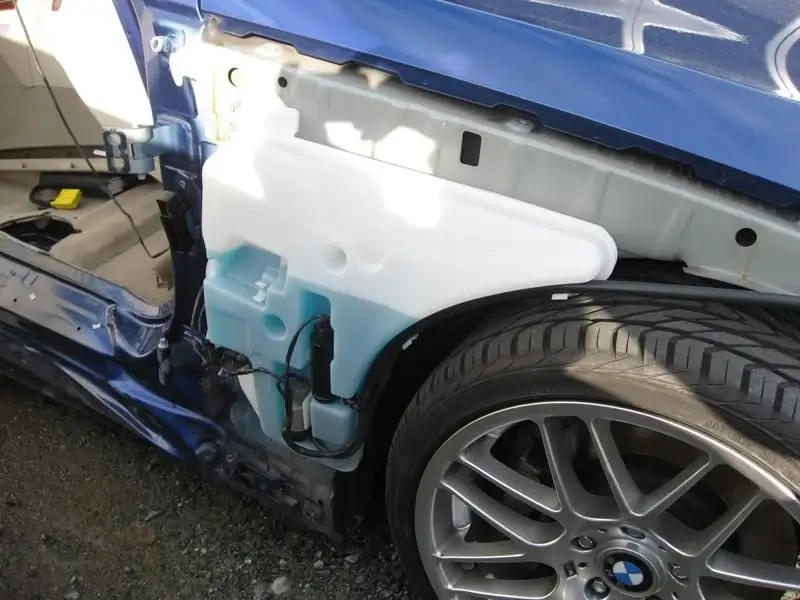
The windshield washer reservoir is typically mounted inside the front fender on late model cars. A faulty reservoir will leak fluid directly under the fender area.
Washer fluid is mostly water, dishwashing detergent and alcohol. So it will feel watery and have a blue or green cast to it.
The windshield washer reservoir on late model vehicles is usually located inside the fender behind the wheel well cover. If the front leak is near a tire and feels like water, is blue or green, chances are the windshield washer reservoir is leaking.
Power steering fluid leak
Power steering fluid is either red or clear when new. Older power steering fluid can have a reddish/brown color, clear, or grey.
Power steering fluid is an oil, so it feels oily when touched. It has an oil smell or even a burned smell.
A power steering fluid leak, if left untouched, can result in total power steering failure.
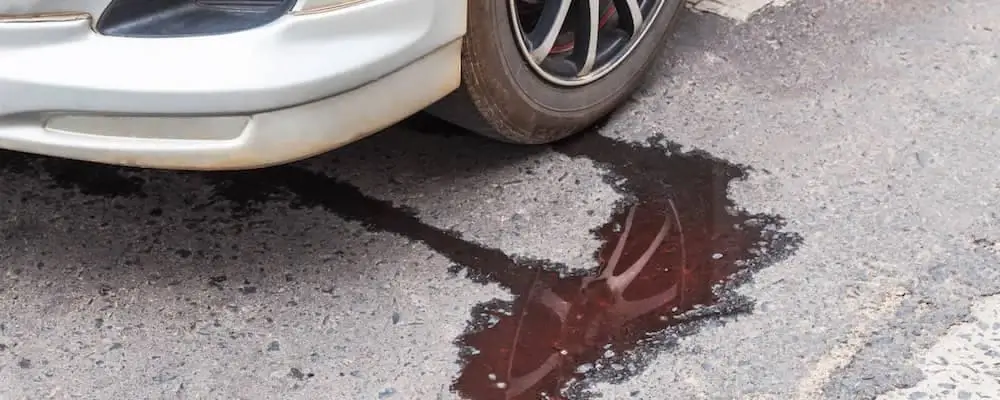
This is a typical power steering fluid leak. Notice the reddish color. Power steering fluid can leak from the reservoir, the pump, power steering hoses, or the power steering gear (rack and pinion).
Motor oil leak
Motor oil can leak from the oil pan gasket, valve cover gasket, 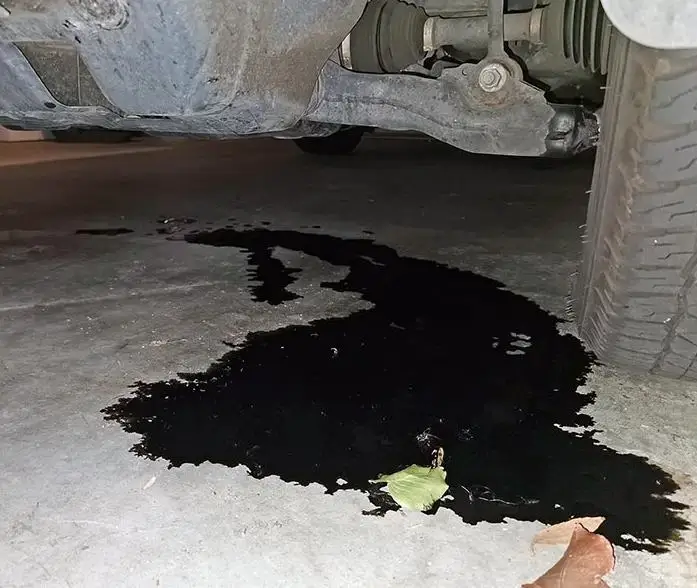 timing cover gasket, oil cooler gasket or oil filter gasket.
timing cover gasket, oil cooler gasket or oil filter gasket.
Fresh motor oil has a slight golden/honey color, but used motor oil appears brown, dark brown or even black. It has an oily feel when you touch it with your fingers. It can smell burned or even have a fuel/solvent smell.
If you find a puddle of oil, as opposed to just drips, that indicates a serious leak that should be checked out immediately.
Transmission fluid leak
Transmission fluid is an oil and will feel oily. It can be red, reddish/brown or even dark brown. It can leak from the transmission oil pan, near the axle shafts, or from a transmission cooling line that runs from the transmission to the transmission cooler located inside the radiator.
If you suspect a transmission fluid leak, get it checked out right away.
Middle leaks — liquid leaks under the middle of your car
AC condensation puddle of water
If you’ve been using your AC, park your vehicle and then notice a puddle of clear liquid under the middle, front passenger seat area, you’re looking at condensation from your AC unit. This is normal and no further action is needed.
Motor oil
Motor oil can leak from the backside of your engine and appear on the ground near the middle of the car.
Transmission fluid
The transmission of FWD vehicles is located in the engine compartment. But on RWD vehicles, the transmission is located behind the engine and leaks will appear mostly under the middle of the vehicle.
Transmission fluid is an oil and will feel oily. It can be red, reddish/brown or even dark brown. It can leak from the transmission oil pan, near the axle shafts, or from a transmission cooling line that runs from the transmission to the transmission cooler located inside the radiator.
Leaks toward the rear of your car
Differential gear oil leak
On RWD vehicles, the differential can sometimes cause an oily leak on the ground under the rear of the vehicle. Differential gear oil feels thicker than motor oil and has a fishy smell. It can appear dark brown or grey, or even black. If the differential has wet areas, get it inspected by a shop ASAP.
AC condensation on vehicles with rear AC
On vans with rear AC, the condensation drain tube will drain water on the side of the vehicle where the AC unit is located (usually on the passenger side). If you’ve driven the vehicle with the AC on and then park it and find a puddle of clear water on the ground below the AC unit, it’s condensation from the AC. This requires no further investigation.
Gasoline leaks under rear of vehicle
Gasoline leaks rarely leave a large puddle under the vehicle unless it’s a very serious leak. In most cases, a small fuel leak will evaporate long before it forms a puddle. If you suspect a fuel leak, examine the tank and notice how much dirt is over the entire surface. If you see a area that looks like it was cleaned recently, that’s the sign of a fuel leak; the fuel washes off the dirt.
Leaks near a tire
A fluid leak near a tire is almost always the sign of a break line/hose failure or a leaking brake caliper or wheel cylinder.
Fresh brake fluid has a clear, golden, honey color. Used brake fluid is brown or dark brown. It is thin and has a slightly oily feel. It has no smell.
If you see a puddle near a tire (and the puddle isn’t directly under a rear AC unit in a van), check the brake fluid level in the brake fluid reservoir. If it’s low, get the vehicle diagnosed ASAP. A brake fluid leak is serious and can cause total brake failure.
©, 2023 Rick Muscoplat

